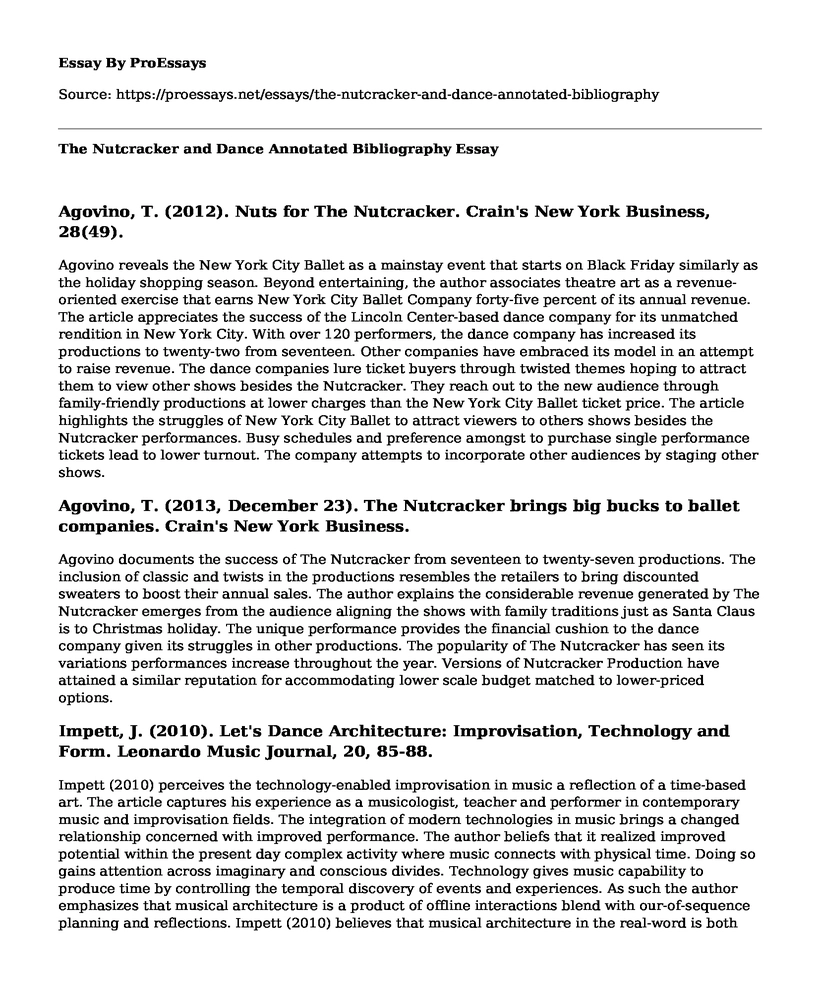Agovino, T. (2012). Nuts for The Nutcracker. Crain's New York Business, 28(49).
Agovino reveals the New York City Ballet as a mainstay event that starts on Black Friday similarly as the holiday shopping season. Beyond entertaining, the author associates theatre art as a revenue-oriented exercise that earns New York City Ballet Company forty-five percent of its annual revenue. The article appreciates the success of the Lincoln Center-based dance company for its unmatched rendition in New York City. With over 120 performers, the dance company has increased its productions to twenty-two from seventeen. Other companies have embraced its model in an attempt to raise revenue. The dance companies lure ticket buyers through twisted themes hoping to attract them to view other shows besides the Nutcracker. They reach out to the new audience through family-friendly productions at lower charges than the New York City Ballet ticket price. The article highlights the struggles of New York City Ballet to attract viewers to others shows besides the Nutcracker performances. Busy schedules and preference amongst to purchase single performance tickets lead to lower turnout. The company attempts to incorporate other audiences by staging other shows.
Agovino, T. (2013, December 23). The Nutcracker brings big bucks to ballet companies. Crain's New York Business.
Agovino documents the success of The Nutcracker from seventeen to twenty-seven productions. The inclusion of classic and twists in the productions resembles the retailers to bring discounted sweaters to boost their annual sales. The author explains the considerable revenue generated by The Nutcracker emerges from the audience aligning the shows with family traditions just as Santa Claus is to Christmas holiday. The unique performance provides the financial cushion to the dance company given its struggles in other productions. The popularity of The Nutcracker has seen its variations performances increase throughout the year. Versions of Nutcracker Production have attained a similar reputation for accommodating lower scale budget matched to lower-priced options.
Impett, J. (2010). Let's Dance Architecture: Improvisation, Technology and Form. Leonardo Music Journal, 20, 85-88.
Impett (2010) perceives the technology-enabled improvisation in music a reflection of a time-based art. The article captures his experience as a musicologist, teacher and performer in contemporary music and improvisation fields. The integration of modern technologies in music brings a changed relationship concerned with improved performance. The author beliefs that it realized improved potential within the present day complex activity where music connects with physical time. Doing so gains attention across imaginary and conscious divides. Technology gives music capability to produce time by controlling the temporal discovery of events and experiences. As such the author emphasizes that musical architecture is a product of offline interactions blend with our-of-sequence planning and reflections. Impett (2010) believes that musical architecture in the real-word is both evolving and adaptive realized through improvising with technology. The relevancy of the article to dance appreciation reveals in posing a technical challenge musicians need to improvise through technique. It requires musicians to inscribe themselves through telegraphic improvisation during performance.
Paul, J. S. (2007). The Soul Purpose Liturgical Dance Troupe. Baylor Journal of Theatre and Performance, 4(2), 83-85.
The article enumerates contributions of John Paul in the formation of Soul Purpose initially as a liturgical drama troupe. Paul motivation in forming the drama troupe as an engaging platform for Valparaiso University students in plays during church services. Soul Purpose would provide students a connective channel between the love of theatre and Christian faith commitments. The primary objective was improving the students' skills through performance opportunities in different physical circumstances. Secondly, operating as a touring theatrical company allowed students to interact with acting operations. The article acknowledges students' voluntary facilitating the running of Soul Present. It would draw diverse membership including Christian denominations, academic majors, and geographical origins. Beyond the performance from Lectionary texts, Soul Purpose has featured in fellowship meetings, church supper theatres, and hotel ballrooms. Its performances trace from the liturgical drama by European Christian churches in early Middle Ages. The article is relevant to the course by challenging students' participation in theatre art to accomplish the humanity agenda.
References
Agovino, T. (2012). Nuts for The Nutcracker. Crain's New York Business, 28(49).
Agovino, T. (2013, December 23). The Nutcracker brings big bucks to ballet companies. Crain's New York Business.
Impett, J. (2010). Let's Dance Architecture: Improvisation, Technology and Form. Leonardo Music Journal, 20, 85-88.
Paul, J. S. (2007). The Soul Purpose Liturgical Dance Troupe. Baylor Journal of Theatre and Performance, 4(2), 83-85.
Cite this page
The Nutcracker and Dance Annotated Bibliography. (2022, Jul 07). Retrieved from https://proessays.net/essays/the-nutcracker-and-dance-annotated-bibliography
If you are the original author of this essay and no longer wish to have it published on the ProEssays website, please click below to request its removal:
- Essay on Lysistrata in Both the Play Lysistrata and the Movie Chi-Raq
- Social Media and Retail Operations Essay
- Django (1966) Movie Essay
- Essay Sample on Gucci With Alessandro Michele Versus Gucci With Frida Giannini
- Movie Analysis Essay on The Century of the Self
- Disney's Fairytales: Breaking the Spell of Gender Stereotypes - Essay Sample
- Paper on New Journal Assignment Power and Its Three Dimensions According to Stevens Lukes Definition







